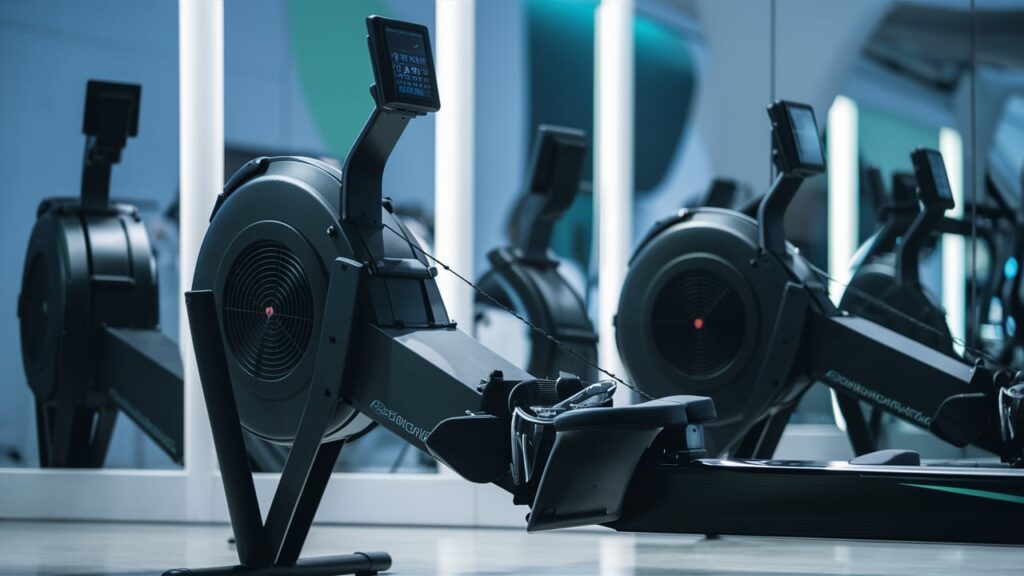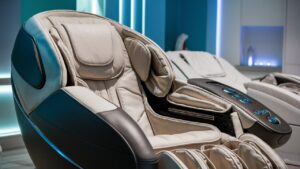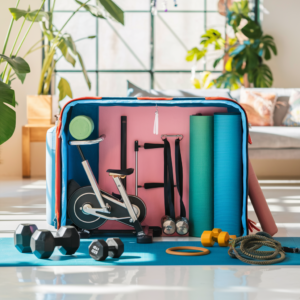Rowing machines offer an effective full-body workout. They target multiple muscle groups at once.
Incorporating a rowing machine into your fitness routine can significantly enhance your overall workout experience. This versatile equipment provides a low-impact exercise that engages your arms, legs, core, and back. Not only does it improve cardiovascular health, but it also builds strength and endurance.
Whether you’re a beginner or a seasoned athlete, a rowing machine can adapt to your fitness level and goals. This introduction will help you understand how this powerful tool can complement your exercise regimen, ensuring you achieve a balanced and efficient full-body workout. Get ready to discover the benefits of rowing machines and how they can elevate your fitness journey.
Introduction To Rowing Machines
Rowing machines provide a full-body workout by engaging multiple muscle groups. They improve cardiovascular health, build strength, and enhance endurance. Perfect for a balanced fitness routine.
Rowing machines offer a comprehensive workout for your entire body. These machines simulate the action of rowing a boat. They engage multiple muscle groups at once. This makes them highly effective for fitness enthusiasts.
What Is A Rowing Machine?
A rowing machine, or rower, mimics the rowing of a boat. It has a seat, footrests, and handles connected to a flywheel. The user pulls the handle, sliding the seat back and forth. This motion works your legs, core, and upper body. The resistance can be adjusted to increase or decrease the workout intensity.
History And Evolution
Rowing machines date back to the 19th century. Early models were simple and used for training rowers. Over time, the design improved for better efficiency and comfort. By the 1980s, modern rowing machines gained popularity in gyms. Today’s rowers come with advanced features. These include digital displays, heart rate monitors, and various resistance settings.
Rowing machines have come a long way. They continue to evolve with technology. This makes them a valuable tool for full-body workouts.
“`
Benefits Of Rowing Workouts
Rowing machines offer a range of benefits that can enhance your workout routine. These benefits go beyond just burning calories. They engage multiple muscle groups and improve cardiovascular health. This section will explore the key Benefits of Rowing Workouts.
Cardiovascular Health
Rowing is an excellent way to boost your cardiovascular health. It increases your heart rate and improves your lung capacity. A regular rowing routine can help lower your risk of heart disease.
Here are some key benefits:
- Improves heart function
- Boosts lung capacity
- Enhances blood circulation
Muscle Strengthening
Rowing is a full-body workout that targets multiple muscle groups. It engages your arms, legs, and core. This makes it an effective way to build muscle strength.
Here is a table showing the muscle groups worked during rowing:
| Muscle Group | Exercise Involved |
|---|---|
| Arms | Pulling the handle |
| Legs | Pushing with your legs |
| Core | Stabilizing the body |
Rowing helps in muscle strengthening and improves overall fitness.
Full-body Engagement
Rowing machines provide a complete workout, engaging arms, legs, and core. They enhance strength, endurance, and overall fitness. Ideal for a balanced full-body exercise.
Rowing machines offer a comprehensive workout. They engage multiple muscle groups. With each stroke, you activate your entire body. This makes rowing a great choice for a full-body workout.
Upper Body Involvement
Rowing machines work your arms and shoulders. Each pull engages your biceps and triceps. Your shoulders also get a workout. The back muscles benefit too. They strengthen with every rowing motion. This leads to better posture and upper body strength.
Lower Body Involvement
Rowing is not just about the arms. Your legs play a big role too. Pushing off with your legs engages your quadriceps. Your hamstrings and calves also get worked. This makes rowing a great lower-body exercise. It strengthens and tones your legs effectively.
“`
Rowing Techniques
Mastering rowing techniques can transform your workout experience. It ensures efficiency and safety. Proper form and avoiding common mistakes are crucial. Let’s dive into these aspects to enhance your rowing routine.
Proper Form
Maintaining proper form is essential for effective rowing. Start with a strong posture. Sit tall with your back straight. Keep your shoulders relaxed. Grip the handle lightly. Engage your core throughout the motion. Push off with your legs first. Follow through with your arms. Extend fully before returning to the start position. Focus on smooth, controlled movements. This prevents injury and maximizes your workout.
Common Mistakes
Common mistakes can hinder your progress. Avoid leaning too far back. This strains your lower back. Don’t grip the handle too tightly. It causes unnecessary tension. Ensure your legs do most of the work. Many beginners overuse their arms. Keep your strokes consistent. Irregular strokes reduce efficiency. Watch your posture. Slouching can lead to discomfort and injury. Correct these mistakes to improve your rowing technique.
Types Of Rowing Machines
Rowing machines are great for a full-body workout. They build strength, endurance, and burn calories. There are different types of rowing machines, each with unique features. Knowing the types can help you choose the best for your fitness goals.
Air Rowers
Air rowers use a flywheel to create resistance. The harder you row, the more resistance you feel. This type of machine offers a smooth and natural rowing experience. They are often used in gyms and by athletes. These machines can be noisy but are effective for intense workouts.
Magnetic Rowers
Magnetic rowers use magnets to create resistance. They are quieter than air rowers. You can adjust the resistance level easily. These machines provide a smooth and consistent rowing motion. They are ideal for home use due to their quiet operation.
Water Rowers
Water rowers use water to create resistance. The resistance increases as you row harder, simulating real rowing on water. They offer a soothing and realistic rowing experience. These machines are quiet and have a natural feel. Water rowers are perfect for those who enjoy a calm workout.
Setting Up Your Machine
Setting up your rowing machine correctly is crucial for a safe and effective workout. This section will guide you through choosing the right model and setting up your space, as well as maintaining your machine. Let’s dive in!
Choosing The Right Model
First, selecting the right rowing machine is essential. There are three main types of rowing machines:
- Air Rowers
- Magnetic Rowers
- Water Rowers
Consider your fitness goals, budget, and space before making a decision. Air rowers are great for a realistic rowing experience. Magnetic rowers are quieter and provide a smoother row. Water rowers mimic the feel of rowing on water.
Here is a quick comparison:
| Model | Pros | Cons |
|---|---|---|
| Air Rower | Realistic feel, adjustable resistance | Can be noisy |
| Magnetic Rower | Quiet, smooth row | Less realistic feel |
| Water Rower | Realistic feel, soothing water sound | Higher cost |
Space And Maintenance
Ensure you have enough space for your rowing machine. Here are some tips:
- Measure the area where you’ll place your machine.
- Leave enough room to move freely around the machine.
- Consider a foldable model if space is limited.
Maintenance is also key to keeping your machine in top shape:
- Wipe down the machine after each use.
- Check for loose bolts and tighten them regularly.
- Lubricate the chain or rail as needed.
Proper setup and maintenance ensure a longer lifespan and a better workout experience. Enjoy your rowing journey!
Creating A Rowing Routine
Creating a rowing routine can transform your workout experience. With a structured approach, you can achieve consistent progress. Let’s dive into different workouts for all fitness levels.
Beginner Workouts
Starting with a rowing machine can seem daunting. Follow a simple plan to ease into it. Begin with a 5-minute warm-up at a slow pace. This prepares your muscles and reduces injury risk. Next, row for 10 minutes at a moderate speed. Focus on your form. Keep your back straight, and engage your core. End with a 5-minute cool-down. Stretch your muscles to relax.
As you get comfortable, increase your time. Add 1 minute to your rowing session each week. This gradual increase helps build endurance. Soon, you will notice improvements in your stamina and strength.
Advanced Workouts
Ready to take your rowing to the next level? Try advanced workouts. Start with a 10-minute warm-up. Use a mix of slow and fast strokes. This gets your heart rate up. Now, focus on interval training. Row at high intensity for 1 minute, then slow down for 2 minutes. Repeat this cycle for 20 minutes. This boosts your cardiovascular health and burns calories.
For more challenge, try a pyramid workout. Row for 1 minute, rest for 1 minute. Then row for 2 minutes, rest for 2 minutes. Continue this pattern up to 5 minutes. Then work back down. This keeps your routine exciting and effective.
By varying your workouts, you keep your body guessing. This leads to better results. With dedication, you will see improvements in your fitness and overall health.
Combining Rowing With Other Exercises
Combining rowing with other exercises can take your fitness routine to the next level. It offers a balanced workout that targets different muscle groups. This combination helps to improve strength, flexibility, and overall body conditioning.
Strength Training
Strength training with weights or resistance bands complements rowing. Rowing targets both upper and lower body muscles. Adding weights enhances muscle growth. Focus on compound exercises like squats, deadlifts, and bench presses. These exercises work multiple muscle groups. They also improve overall strength. Alternate between rowing and strength training sessions. This keeps your routine varied and effective.
Flexibility Exercises
Flexibility exercises are essential for a balanced workout. They prevent injuries and improve performance. After a rowing session, include stretching exercises. Focus on areas like hamstrings, shoulders, and back. Yoga can also be a great addition. It improves flexibility and reduces muscle stiffness. Try poses like downward dog or child’s pose. These stretches complement the rowing motion. They help in maintaining a full range of motion.
Tracking Progress
Tracking your progress is essential for maximizing the benefits of rowing machines. It helps you understand your fitness journey better. You can see where you started and how far you have come. Tracking also keeps you motivated and committed to your goals.
Using Fitness Apps
Fitness apps can be a great tool for tracking progress. Many rowing machines connect to apps via Bluetooth. These apps record your workout data in real-time. They provide detailed analytics on your performance. You can monitor metrics like distance, speed, and calories burned.
Some apps offer features like virtual rowing races. Competing with others can make your workout more exciting. They also provide personalized workout plans. These plans can help you target specific fitness goals.
Setting Goals
Setting clear goals is crucial for effective progress tracking. Start with short-term goals. These could be rowing a certain distance or burning a specific number of calories. Achieving these smaller goals can boost your confidence.
Long-term goals are also important. They keep you focused on the bigger picture. Examples include losing a set amount of weight or improving your rowing technique. Regularly revisiting and adjusting your goals ensures they stay relevant.

Frequently Asked Questions
What Muscles Do Rowing Machines Work?
Rowing machines work multiple muscles, including legs, core, back, and arms. They provide a full-body workout that builds strength and endurance.
How Often Should I Use A Rowing Machine?
For optimal results, use a rowing machine 3-4 times a week. Consistency is key to improving fitness and achieving goals.
Are Rowing Machines Good For Weight Loss?
Yes, rowing machines are excellent for weight loss. They burn calories efficiently and engage multiple muscle groups, boosting your metabolism.
Can Beginners Use Rowing Machines?
Absolutely, beginners can use rowing machines. They offer adjustable resistance levels, making them suitable for all fitness levels. Start slow and increase intensity.
Conclusion
Rowing machines offer a fantastic full-body workout. They engage multiple muscles, improving strength and endurance. Easy to use, they fit well in any exercise routine. Regular rowing can enhance cardiovascular health and boost overall fitness. It’s a versatile workout tool.
Perfect for all fitness levels. Try incorporating rowing into your workouts. Feel the difference and enjoy a healthier lifestyle.








